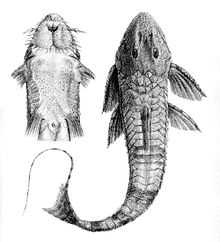Spatuloricaria
| Spatuloricaria | |
|---|---|
 | |
| Spatuloricaria evansii | |
| Scientific classification | |
| Kingdom: | Animalia |
| Phylum: | Chordata |
| Class: | Actinopterygii |
| Order: | Siluriformes |
| Family: | Loricariidae |
| Subfamily: | Loricariinae |
| Tribe: | Loricariini |
| Genus: | Spatuloricaria L. P. Schultz, 1944 |
| Type species | |
| Spatuloricaria phelpsi L. P. Schultz, 1944 | |
| Synonyms | |
| |
Spatuloricaria is a genus of armored catfishes native to Central and South America.
Spatuloricaria is in need of revision, as species boundaries and distributions are poorly known. The phylogenetic position of Spatuloricaria remains uncertain. Spatuloricaria has been placed at the base of a clade including representatives of the Loricaria and Pseudohemiodon groups. Its dentition, with few teeth on the premaxillae, and its abdominal cover consisting of minute disjointed platelets resembles that of some representatives of the Loricaria group. Conversely, the papillose surface of the lips and sexually dimorphic features are more characteristic of the Rineloricaria group.[1]
This genus is distributed in the northwestern part of the South American subcontinent, in drainages of the Pacific and Atlantic Slopes of the Andes. Several species occur also in the upper Amazon River basin, upper Paraguay, and São Francisco River basins.[1]
Sexual dimorphism includes hypertrophied development of claw-like odontodes along the sides of the head and on the pectoral spines in mature males.[1] Ecological data is unavailable and reproductive biology is unknown for Spatuloricaria species.
Species
There are currently 12 recognized species in this genus:
- Spatuloricaria atratoensis L. P. Schultz, 1944
- Spatuloricaria caquetae Fowler, 1943
- Spatuloricaria curvispina Dahl, 1942
- Spatuloricaria euacanthagenys Isbrücker, 1979
- Spatuloricaria evansii Boulenger, 1892
- Spatuloricaria fimbriata C. H. Eigenmann & Vance, 1912
- Spatuloricaria gymnogaster C. H. Eigenmann & Vance, 1912
- Spatuloricaria lagoichthys L. P. Schultz, 1944
- Spatuloricaria nudiventris Valenciennes, 1840
- Spatuloricaria phelpsi L. P. Schultz, 1944
- Spatuloricaria puganensis N. E. Pearson, 1937
- Spatuloricaria tuira Fichberg, O. T. Oyakawa & de Pinna, 2014 (Tuira's whiptail) [2]
References
- ↑ 1.0 1.1 1.2 Covain, Raphael; Fisch-Muller, Sonia (2007). "The genera of the Neotropical armored catfish subfamily Loricariinae (Siluriformes: Loricariidae): a practical key and synopsis" (PDF). Zootaxa 1462: 1–40.
- ↑ Fichberg, I., Oyakawa, O.T. & de Pinna, M. (2014): The End of an Almost 70-Year Wait: A New Species of Spatuloricaria (Siluriformes: Loricariidae) from the Rio Xingu and Rio Tapajós Basins. Copeia, 2014 (2): 317-324.